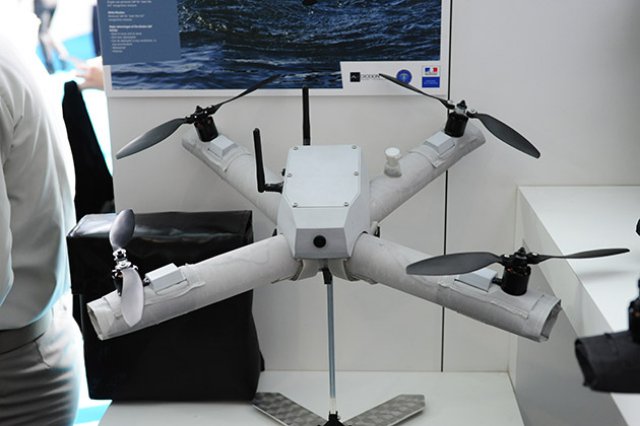French start-up company Airvada presented its range of innovative DIODON inflatable unmanned air vehicles (UAVs) at SOFINS, near Bordeaux.
The idea which led to the DIODON family was to develop a UAV using an inflatable structure, which would allow for a lighter and much more robust aircraft than comparable products already in the market.
All DIODON aircraft feature a rigid main body with four to six inflatable ‘arms’, each of which has a single engine and propeller at its extremity.
The UAV is transported in a simple backpack when fully folded instead of a rigid case as its inflatable structure does not require the same protection as a rigid airframe drone.
To deploy it, the operator simply needs to remove it from its pack and inflate it using a CO2 cartridge. The entire process takes 30 seconds while the folding and repacking process at the end of a flight requires no more than 60 seconds.
As explained by one of the creators of Airvada to Shephard, the main benefits of the DIODON are its resistance due to the shock absorbing properties of its inflatable structure, its floatability (the DIODON family is fully waterproof and can thus land on water) and its compactness when folded.
The fabric used for its inflatable parts comes from the aeronautics industry and is robust, allowing the DIODON UAV to land on any kind of rocky surface without risk of damage.
The DIODON concept was initially developed for civilian leisure applications in 2015, although Airvada soon realised the product was in fact better suited to the professional market.
Interest in the type arose recently from the French Special Operations Command (COS), which has witnessed several demonstrations and is now intent in trialling it. The French SF are particularly interested in the type’s flexibility and its ability to be deployed rapidly for ‘over the hill’ reconnaissance flights.
The DIODON family currently comprises three models: the HP150, the MP40 and the SP20.
The HP150 is the largest product in the range. Motorised by six electric waterproof Brushless engines each powering a single propeller, it has a maximum endurance of 30 minutes and a payload of 1.5 kg which can be a stabilised EO or IR camera. Its wingspan when inflated is 1500mm.
The MP40 also features six engines but has an endurance of only 20 minutes with a 0.4kg payload such as an EO or IR camera with two axis stabilisation. Its wingspan is 900mm when inflated.
The SP20 is the smallest aircraft in the range and only has four engines. It can embark a 0.2kg payload consisting of an unstabilised mini camera and has an endurance of 20 minutes. Its wingspan when inflated is 60mm.
While Airvada is for now primarily focused on the French market, its founders are not adverse to the idea of exploring export opportunities in the future, once their products have established a more significant commercial footprint in France as they told Shephard.
Source: Shephard

